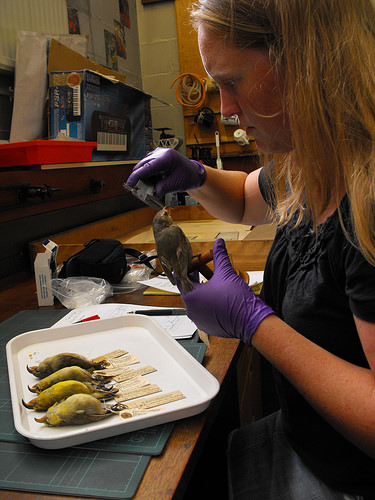Past Research
Graduate Student Research ProjectsMFBRP occasionally coordinates and conducts research with graduate students focusing on birds and ecosystems on Maui. Here is selection of past work. If you are interested in becoming an MFBRP graduate student, please visit here.

‘AKOHEKOHE MOVEMENTS
Graduate student, Alex Wang through the University of Hawai‘i – Hilo, investigated the dispersal of ‘Ākohekohe. Alex used radio-telemetry to document ‘Ākohekohe movements and take foraging observations of both adults and juveniles. Radio telemetry uses a small transmitter to emit radio waves, which are then picked up by a receiver through an antenna. Each transmitter has its own frequency, like a radio station. To track the bird, the researcher used the antenna and the receiver, which was dialed in to a specific individual’s frequency. The researcher could then get close enough to each bird to read their color-bands and confirm their identity. Alex was able to record hourly and daily movements, monitoring foraging and breeding habits as well.
A total of 29 ‘Ākohekohe adults and juveniles were followed over two breeding seasons. Alex found that adults tended to stay in the same general area and juveniles roamed over much larger areas. These long-distance movements led a few individuals to briefly dip lower in elevation, where higher densities of mosquitoes can persist. Although the individuals that ventured lowest eventually returned to higher elevations, the juveniles are likely at greatest risk for disease exposure.
Publications and Presentations:
- Wang Alex X, Paxton E.H, Mounce H.L, Hart PJ. 2020. Divergent movement patterns of adult and juvenile ‘Akohekohe, an endangered Hawaiian Honeycreeper. Journal of Field Ornithology.
- Wang AX. 2015. Movement patterns of adult and juvenile ‘Ākohekohe (Palmeria dolei). Presentation. Hawai’i Conservation Conference, Hilo, HI. View presentation here.
- Wang AX. 2014. The presence of an ecological trap in the juvenile dispersal of the ‘Ākohekohe (Palmeria dolei), a population limiting life stage? Poster Presentation. Hawai’i Conservation Conference, Honolulu, HI.

KIWIKIU GENETICS
Genetic diversity (the variability of genes in a species) is fundamental to biodiversity. Conservation of genetic variation is important to the overall health of populations. Decreased genetic variability leads to increased levels of inbreeding, reduced fitness, and could accelerate species extinction.
Specific genetic techniques are used to assess the genetics of a species regarding specific conservation issues as well as general population structure. As a graduate student at the University of Kent in the United Kingdom (in conjunction with University of Hawai’i Mānoa), MFBRP manager, Hanna Mounce used microsatellites and mtDNA sequence data to analyze the current and historic population structure and diversity of the Kiwikiu. These techniques provide information on the current diversity structure in the wild and have been used to design knowledgeable management decisions for this species in the future.
Publication:

ALIEN FOREST USE
Due to extensive habitat destruction, the Maui ‘Alauahio occurs in two known disjunct populations where habitat conditions vary extensively. The primary population occurs in wet and mesic montane native forests. The second separate population occurs in non-native forests within Polipoli State Recreation Area or Kula Forest Reserve.
Graduate student, Peter Motyka, through Northern Arizona University investigated the use of non-native forest by native birds to facilitate the ability to evaluate the management of non-native forest for the benefit of native forest bird species. The project included color-banding and resighting Maui ‘Alauahio, quantifying vegetation structure for foraging habits, conducting variable circular plot point counts for bird densities, and nest searching and monitoring. Read the full thesis here.
Because of this initial study on native bird use of non-native forest, MFBRP continues conducting point counts as well as monitoring birds with bird banding and disease prevalence- studies at this site. This study advanced both our ability to make conservation management recommendations as well as our perception of the potential for managing unnaturally altered habitat areas for the benefit and support of native species.
Save the Forest, Save the Birds
It takes a community of dedicated individuals and support to make conservation happen
